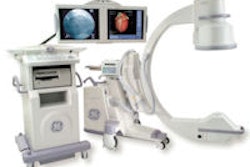A retrospective study of more than 40,000 computed radiography (CR) exams obtained from six University of Maryland departments suggests wide variations in protocols among hospital departments and slightly higher-than-necessary radiation exposure to patients, particularly children.
Computed radiography manufacturers have developed unique image receptor incident exposure indexes, explained Zhitong Yang, Ph.D., assistant professor of diagnostic radiology and nuclear medicine at the University of Maryland School of Medicine in Baltimore. Yang presented the data at the American Association of Physicists in Medicine (AAPM) meeting in July in Houston.
In systems manufactured by Fujifilm Medical Systems USA, it's the sensitivity number (S#), while Carestream Health's systems use an exposure index (EI), and Agfa HealthCare's systems use a logarithm of the median of the image signal intensity histogram (LgM).
Building on phantom studies that have looked at optimizing exposure techniques, Yang's team analyzed statistics from Agfa's image receptor exposure index taken from patient images obtained in clinical practice from six departments over a five-month period.
A total of 40,936 exams were made available for the analysis, with 183 low-occurrence exams thrown out to maintain statistical significance. The remaining 40,753 exams were categorized into 15 patient age or size groups and 93 exposure types. The average exposure index and the exposure index distribution were calculated for each category.
About half of the total exams were chest cases, followed by lower extremity studies at 21% and upper extremity and abdominal cases at 10% each. There was a greater tendency to overexpose pediatric patients in abdominal exams than adults. Average exposure indexes centered at 2.1 for LgM, compared to the manufacturer's recommendation of 1.9 ~ 2.2 LgM.
Among the six departments, the highest LgM was recorded in the intensive care unit, followed by ER, surgery, and orthopedics. In some cases the variation of the index was very large, said Yang. In general, more images were underexposed than overexposed, and chest images had less exposure than abdomen images.
Computed radiography exams included the full range of pathology, from routine diagnostic images to "ER, trauma, chest, some gunshot wounds, and car accidents," said Yang. (The researcher herself became part of the study following a broken foot that was imaged using CR.)
Yang noted that some vendor guidelines for radiologic technologists, if followed, call for higher exposure techniques than those for the same studies with film-screen systems.
Guidelines by their nature are not one-size-fits-all, and it falls on the radiologist to determine when to trade reduced patient dose for reduced image quality. "In each case you have to weigh the benefit and the risk," Yang said.
The study concluded that changing protocols to include more detailed recording of the image technique and beam quality used for each case and incorporating that information into DICOM header files could improve system monitoring and lead to better overall clinical practices.
"Consistent quality control procedures for computed radiography systems are as important as, if not more than, QC for traditional screen/film systems to deliver satisfactory image quality and patient care," Yang said.
Yang is encouraged by the movement of medical radiology societies toward more carefully scrutinized protocols, particularly in the development of downsized adult or weight-appropriate pediatric imaging guidelines. "Kids' organs are more radiosensitive because of rapidly dividing cells," she added.
AAPM along with the Society for Pediatric Radiology (SPR), the American Academy of Radiology (AAR), and the American Society of Radiologic Technologists (ASRT) founded the Alliance for Radiation Safety in Pediatric Imaging, also known as the Image Gently Alliance, which launched in January. The group is putting its initial focus on pediatric CT scans, aiming to change practices.
By Kathlyn Stone
AuntMinnie.com contributing writer
September 3, 2008
Related Reading
New studies examine CR, CT radiation dose, March 9, 2008
Studies examine digital methods for reducing pediatric x-ray dose, October 9, 2007
PACS data-mining technique tackles CR dose creep, July 30, 2007
DICOM-compliant displays aid CR/DR exposure control, July 17, 2007
Strategies for reducing 'dose creep' in digital x-ray, April 11, 2007
Copyright © 2008 AuntMinnie.com



















